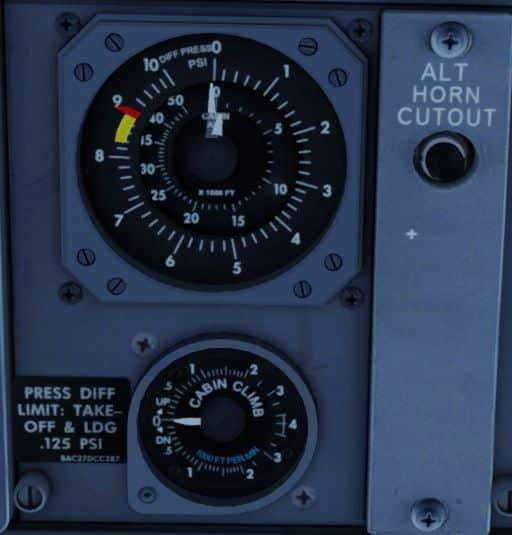On aircraft which fly at high-level altitudes, pressurization systems are required in order for the occupants to breathe.
Pressurization systems are comprised of a balance between providing sufficient oxygen levels to those onboard while placing minimal stress on the aircraft’s structure.
With these pressurization systems, there are numerous terms used to address the key components for assessing cabin pressure.
What is Cabin Altitude?
Cabin altitude refers to the altitude Above Mean Sea Level (AMSL) to which the aircraft cabin is pressurized to. Between 6,000 – 8,000 feet is the standard cabin altitude in most large commercial aircraft. This setting provides occupants with a comfortable level of oxygen.
Cabin air is controlled via cabin pressure controllers which regulate the inbound and outbound airflow into the cabin. On most commercial aircraft, cabin pressurization is provided via engine compressor bleed air.
Above 8,000 feet, the human body struggles as oxygen levels drop. This leads to an onset of a condition known as hypoxia, in which the body becomes starved of oxygen. This will lead to a loss of consciousness in a very short space of time.
Due to this, pressurized commercial aircraft are fitted with cabin altitude gauges, in which cabin altitude can be monitored. In the event of cabin altitude climbing past 8,000 feet, an aural warning will alert the flight crew.
This gives sufficient time for an emergency descent to be initiated along with the deployment of supplemental oxygen. On the Boeing 737 Next Generation series of aircraft, a cabin altitude horn is fitted to alert the flight crew of the rise in cabin altitude.
On the 737, the cabin altitude horn will be activated at 10,000 feet cabin altitude followed by the automatic deployment of oxygen masks at 14,000 feet cabin altitude.
The supplemental oxygen supply onboard most aircraft has the capacity for 10-12 minutes of use. This window allows for an emergency descent to be made to flight levels in which oxygen is not required (typically 8,000-10,000 feet).

Dependent on the cruising altitude, the cabin altitude will increase incrementally after takeoff. This gradual increase prevents occupants from experiencing pressure bump, which is uncomfortable on the ears. The gradual increase of cabin altitude prevents this from occurring.
The same applies during the descent phase of flight, in which aircraft cabin altitude is gradually decreased in accordance with the aircraft’s altitude.
This prevents sudden change to the pressure in occupants’ ears, in which eardrum damage could be a result.
Differential Pressure
Differential pressure is the difference between the cabin pressure and the air pressure outside the cabin in flight. Monitoring and regulating this either manually or via the aircraft pressurization system is integral for calculating the stress placed on the fuselage.
Due to the change of air pressure with altitude, this is another factor for ensuring gradual increase and decrease of cabin altitude when the aircraft is ascending or descending.
The differential pressure should remain within the limits specified by the manufacturer.
Cabin differential pressure is measured in Pounds per Square Inch (psi).
Cabin Pressure Control
As discussed above, cabin pressure is typically controlled automatically by the aircraft’s onboard cabin pressure controllers, which form part of a system that regulates and monitors air entering and exiting the aircraft fuselage.
Air is released via the outflow valve, a small opening located on the fuselage. This removes any excess air pressure inside the cabin.
In the event of the outflow valve failing, a secondary outflow valve can be activated via the pop of a frangible disk. This frangible disk acts as a safety device in which it will separate from the aircraft in the event of a failure of the primary outflow valve, automatically activating the secondary outflow valve.
During the walkaround/pre-flight phase, the flight crew must verify that this disk is in place to ensure the primary outflow valve has not failed on the preceding flight.
On the pressurization panel of most aircraft, there are options for the controlling of cabin pressure to be MANUAL or AUTO. In most operational circumstances, this will be selected to AUTO. For maintenance purposes, MANUAL mode may be engaged to test or troubleshoot for pressurization-related issues.
It is integral for the flight crew to ensure pressurization is set to AUTO prior to flight. This has been emphasized in training practices following the 2005 loss of a Boeing 737-300 due to MANUAL mode being left inadvertently selected following maintenance. Full report of this incident can be read here.
Pressurizing the Cabin
In most commercial aircraft, the aircraft packs will be switched to ON/AUTO during the post-engine start phase of checklists.
This will feed bleed air from the compressor section of the engine into the cabin. On some aircraft such as the Boeing 787, there is a no-bleed pressurization system in place. This conserves engine bleed air and increases takeoff performance.
Read More:
Do Aircraft Serial Numbers Change? | Difference Between an Aircraft Registration and Serial Number

After visiting more than 60 countries, I have probably been on every type of plane there is and visited countless airports. I did my very first international solo trip to South Africa at the age of only 16 and haven’t really stopped traveling since.
Despite the adventurous travel itch, I do have a nerdy side as well – which is satisfied by writing about all things aviation “too boring” for my regular travel blog.
